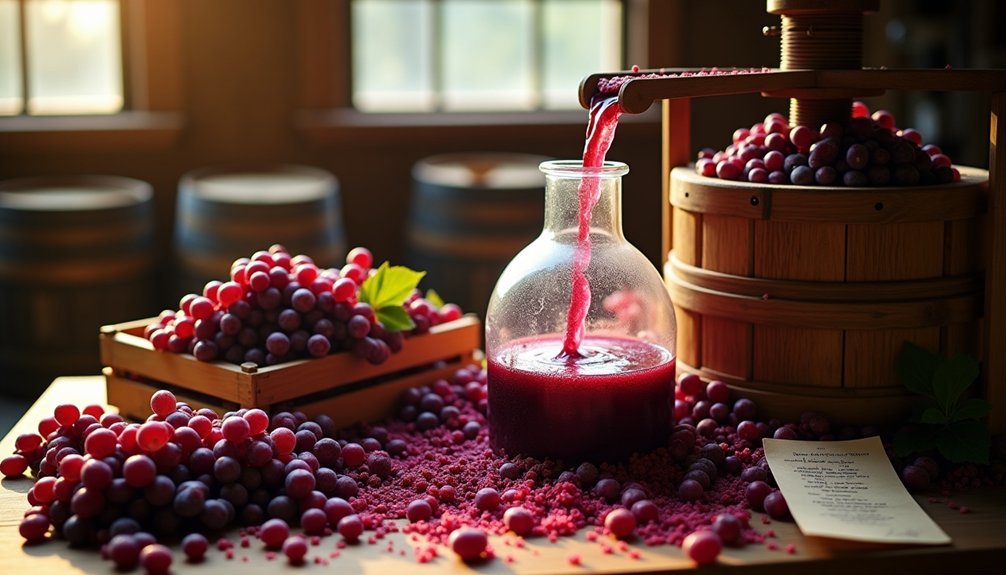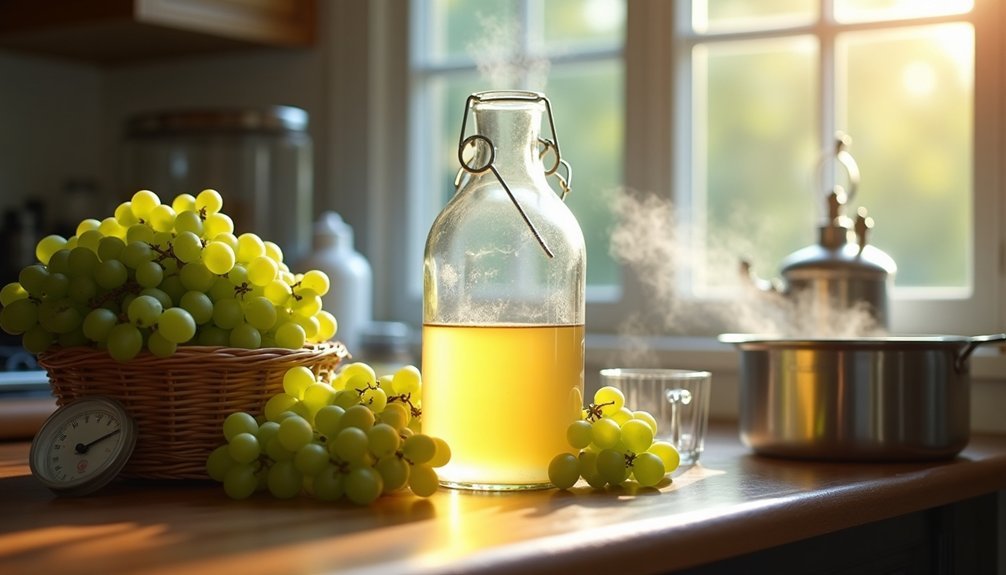I’ve crafted red wine from scratch for over a decade, and I still find magic in transforming humble grapes into something extraordinary. There’s nothing quite like pouring a glass of wine you’ve made with your own hands, knowing exactly what went into it. The process isn’t complicated, but it does require patience and attention to detail. If you’ve ever wondered what gives homemade wine its distinctive character compared to store-bought varieties, you’re about to discover the secret.
Why You’ll Love This Drink
Although commercial wines offer convenience, nothing compares to the satisfaction of crafting your own rustic red wine. I’ve found that homemade wine connects you to ancient traditions while giving you complete control over ingredients and processes.
You’ll appreciate the rich, complex flavors that develop from fresh grapes rather than concentrates. There’s something magical about watching the transformation from fruit to alcohol through natural fermentation.
The recipe is surprisingly simple, requiring just grapes, yeast, and a few additives. With minimal equipment and patience, you’ll create a unique beverage that reflects your personal taste preferences.
Best of all, sharing your homemade wine with friends creates memorable moments. They’ll be impressed by your craftsmanship and the authentic character that store-bought wines simply can’t match.
Ingredients
The heart of any great homemade wine starts with selecting the right components. For my rustic red wine recipe, you’ll need 1.5 kg of ripe, flavorful grapes—preferably dark varieties like Cabernet Sauvignon or Merlot if available.
You’ll also need 0.5 grams of Potassium MetaBiSulphate to prevent unwanted bacteria growth, 100 grams of sugar or glucose to feed the yeast, and 1 gram of quality red wine yeast to drive fermentation. Don’t forget 0.3 grams of yeast nutrients to keep your fermentation healthy and vigorous.
I sometimes use optional fining agents at the end of the process to clarify the wine, but many home winemakers skip this step for a more natural product. A hydrometer is helpful but not essential for monitoring your fermentation progress.
Directions
Once you’ve gathered all ingredients, making rustic red wine begins with preparing the grapes. I recommend thoroughly crushing them to release their juices, then adding the Potassium MetaBiSulphate to kill wild yeasts and bacteria.
After 24 hours, mix in your sugar and red wine yeast. Transfer this mixture to your primary fermenter, keeping the temperature between 26-30°C. I’ve found that maintaining this temperature range guarantees ideal fermentation.
Let it ferment for about 8 days, then strain and move to your secondary fermenter. This is where patience becomes essential—leave it undisturbed for 5-6 weeks until fermentation completely stops.
Use a hydrometer to confirm fermentation is complete before bottling. If desired, add fining agents a week before bottling to clarify your wine.
Substitutions and Variations
Several variations of this rustic red wine recipe can accommodate different tastes and ingredient availability. I’ve found that while Cabernet Sauvignon, Merlot, or Zinfandel grapes work best, you can substitute any dark-skinned grapes you have access to. Don’t worry if you can’t find red wine yeast – champagne yeast makes an excellent alternative.
For a sweeter finish, increase the sugar to 150g, or use honey instead for a more complex flavor profile. If potassium metabisulphate isn’t available, crushed Campden tablets work just as well (1 tablet per gallon).
You can also add oak chips during secondary fermentation for a more sophisticated flavor, or blend different grape varieties for a custom wine that reflects your personal taste preferences.
Additional Things to Serve With This Drink
When serving your homemade rustic red wine, I recommend pairing it with foods that complement its robust character. A charcuterie board with aged cheeses like Gouda or Parmesan creates a delightful balance with the wine’s tannins. Include some Manchego or blue cheese for bolder pairings.
Red meat dishes—particularly lamb, beef stew, or grilled steaks—enhance the wine’s earthy notes. For vegetarian options, try mushroom risotto or roasted eggplant with herbs.
Don’t forget dark chocolate for dessert! The bitterness plays beautifully against the wine’s fruit characteristics. I also suggest serving your wine in proper stemware at slightly below room temperature (around 65°F) to fully appreciate the aromas you’ve cultivated through your fermentation process.
Final Thoughts
Beyond perfect pairings, making your own rustic red wine brings a deep satisfaction that store-bought bottles simply can’t match. There’s something magical about transforming humble grapes into a complex, flavorful beverage through your own efforts. I’ve found that each batch tells its own story—reflecting the quality of grapes, fermentation conditions, and even your patience during the aging process.
Don’t be discouraged if your first attempt isn’t perfect. Wine-making is both science and art, improving with each batch you create. The recipe I’ve shared is forgiving and adaptable, perfect for beginners. Remember that traditional winemakers have been crafting wines for centuries using simple techniques similar to these. Trust the process, enjoy the journey, and soon you’ll be pouring your own signature red for friends and family.



